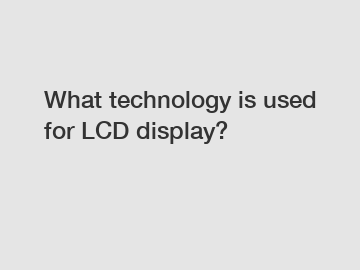Feb. 22, 2024
Electronic Components & Supplies
Highlystar contains other products and information you need, so please check it out.
LCD (Liquid Crystal Display) technology has become ubiquitous in our daily lives, from smartphones to computer screens to televisions. But what technology is actually used to make these displays possible? In this article, we will explore the various components and processes involved in creating an LCD display.
**Liquid Crystals**.

At the heart of an LCD display is liquid crystal - a substance that is neither solid nor liquid, but has properties of both. Liquid crystals are materials that have the ability to change their orientation in response to an electric current. This property allows them to act as shutters, blocking or allowing light to pass through.
**Polarizing Filters**.
Polarizing filters are another key component of an LCD display. These filters are placed on either side of the liquid crystal layer and help to control the amount and direction of light that passes through the display. By using polarizing filters, LCD displays are able to produce images with high contrast and brightness.
**Backlight**.
In order for an LCD display to produce visible images, a backlight is needed to illuminate the screen. The most common type of backlight used in LCD displays is a cold-cathode fluorescent lamp (CCFL) or Light Emitting Diode (LED). The backlight is positioned behind the liquid crystal layer and provides the necessary light for the display to be visible.
**Color Filters**.
To produce full-color images, LCD displays use color filters. These filters are placed on top of the liquid crystal layer and are designed to produce red, green, and blue (RGB) colors. By combining these three primary colors, LCD displays are able to create a wide range of colors and produce vibrant images.
**Thin-Film Transistors (TFT)**.
In order to control the individual pixels on an LCD display, thin-film transistors (TFT) are used. TFTs are small semiconductor devices that act as switches, turning individual pixels on or off. By using TFTs, LCD displays are able to produce high-resolution images with sharp detail.
**Benefits of LCD Technology**.
LCD displays offer several advantages over other display technologies, including:
- Energy efficiency: LCD displays consume less power than traditional cathode ray tube (CRT) displays, making them more energy-efficient.
- Slim design: LCD displays are thinner and lighter than CRT displays, making them ideal for portable devices like laptops and smartphones.
- Sharp image quality: LCD displays are capable of producing high-resolution images with vibrant colors and excellent contrast.
In conclusion, the technology used for LCD displays is a sophisticated combination of liquid crystals, polarizing filters, backlights, color filters, thin-film transistors, and more. By harnessing the properties of these materials and components, LCD displays are able to produce high-quality images that have become an integral part of our modern world.
For more information on LCD technology and how it can benefit your business, contact us today.
For more information, please visit our website.
For more information, please visit lcd display supplier.
If you are interested in sending in a Guest Blogger Submission,welcome to write for us!
All Comments ( 0 )